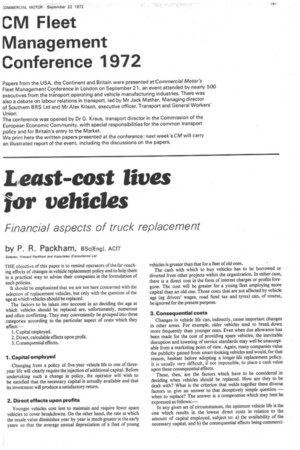Least-cost lives for vehicles
Page 181

If you've noticed an error in this article please click here to report it so we can fix it.
Financial aspects of truck replacement
by P. R. Packham, BSc(Eng), AGIT
Director, Howard Peckham and Associates (Consultants) Ltd
THE objective of this paper is to remind operators of the far-reaching effects of changes in vehicle replacement policy and to help them in a practical way to advise their companies in the formulation of such policies.
It should be emphasized that we are not here concerned with the selection of replacement vehicles, but only with the question of the age at which vehicles should be replaced.
The factors to be taken into account in so deciding the age at which vehicles should be replaced are, unfortunately, numerous and often conflicting. They may conveniently be grouped into three categories according to the particular aspect of costs which they affect: 1. Capital employed.
2. Direct, calculable effects upon profit.
3. Consequential effects.
1. Capital employed Changing from a policy of five-year vehicle life to one of threeyear life will clearly require the injection of additional capital. Before undertaking such a change in policy, the operator will wish to be satisfied that the necessary capital is actually available and that its investment will produce a satisfactory return.
2. Direct effects upon profits
Younger vehicles cost less to maintain and require fewer spare vehicles to cover breakdowns. On the other hand, the rate at which the resale value diminishes year by year is much greater in the early years so that the average annual depreciation of a fleet of young vehicles is greater than that for a fleet of old ones.
The cash with which to buy vehicles has to be borrowed or diverted from other projects within the organization. In either case, there is a direct cost in the form of interest charges or profits foregone. The cost will be greater for a young fleet employing more capital than an old one. Those costs that are not affected by vehicle age (eg drivers' wages, road fund tax and tyres) can, of course, be ignored for the present purpose.
3. Consequential costs Changes in vehicle life can, indirectly, cause important changes in other areas. For example, older vehicles tend to break down more frequently than younger ones. Even when due allowance has been made for the cost of providing spare vehicles, the inevitable disruption and lowering of service standards may well be unacceptable from a marketing point of view. Again, many companies value the publicity gained from smart-looking vehicles and would, for that reason, hesitate before adopting a longer-life replacement policy. It is usually very difficult, if not impossible, to place a cash value upon these consequential effects.
These, then, are the factors which have to be considered in deciding when vehicles should be replaced. How are they to be dealt with? What is the criterion that welds together these diverse factors to give an answer to that deceptively simple question — when to replace? The answer is a compromise which may best be expressed as follows:—
In any given set of circumstances, the optimum vehicle life is the one which results in the lowest direct costs in relation to the amount of capital employed, subject to: a) the availability of the necessary capital, and b) the consequential effects being commerci
































































































































































































































































































































































































































































































































